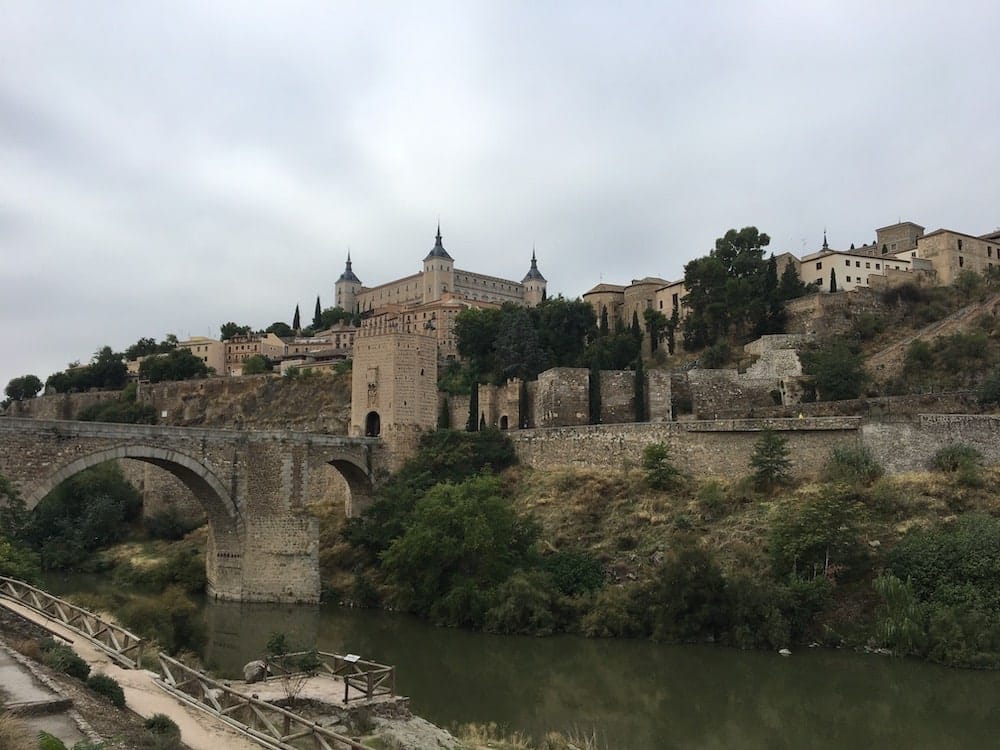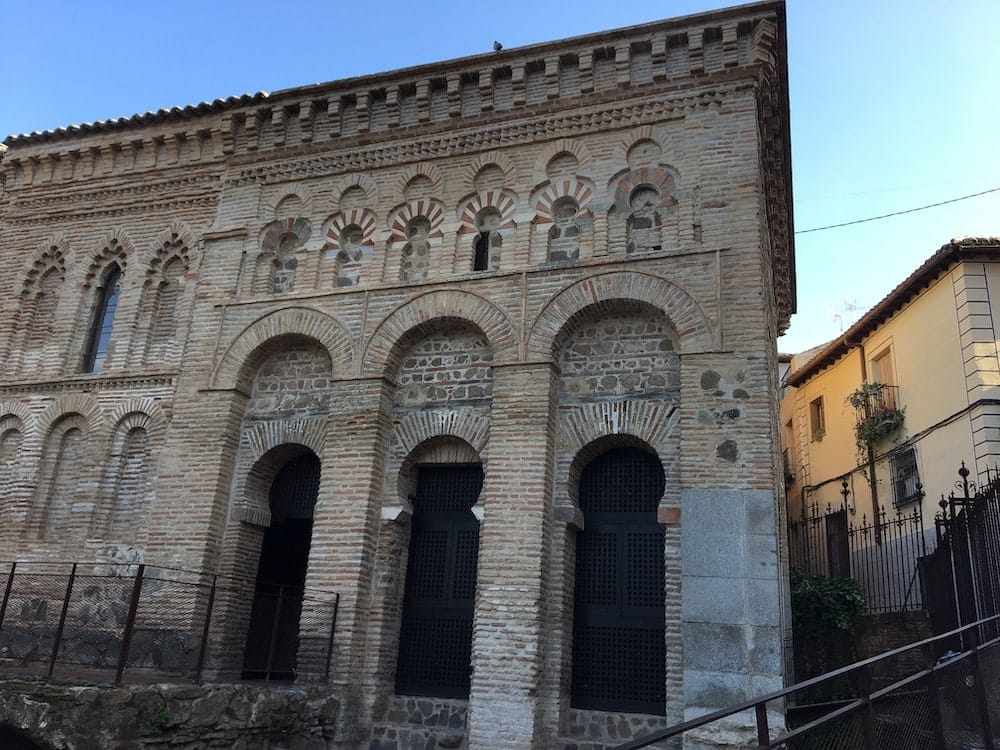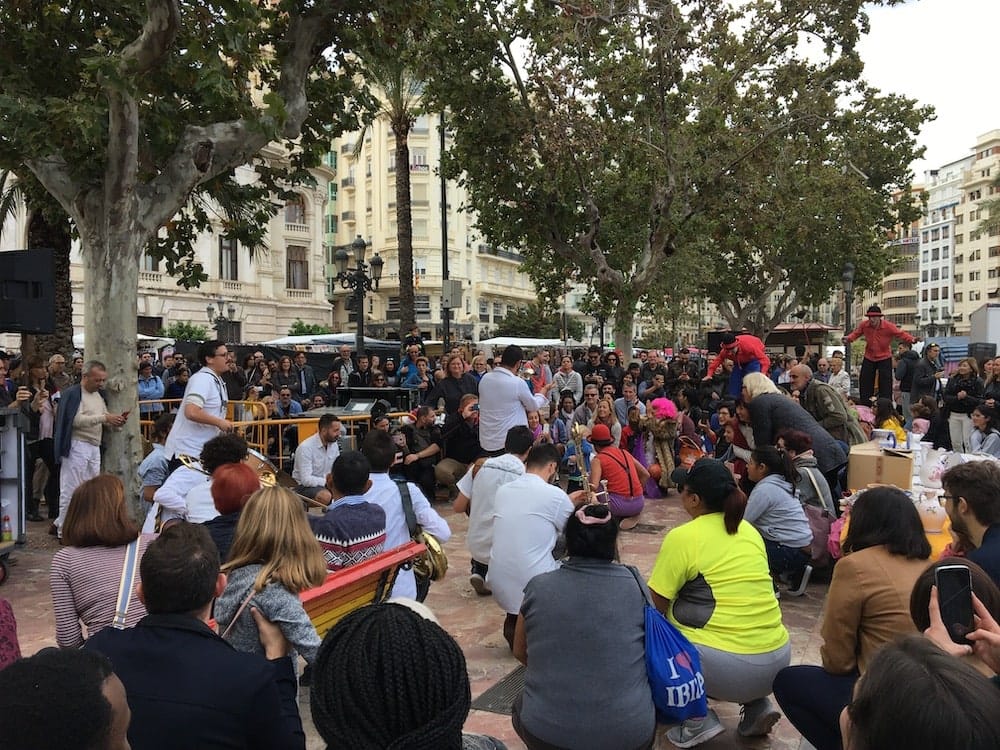Every train we took in Spain left and arrived precisely on time. Buying the ticket wasn’t so efficient. Apparently, you need a special credit card to buy certain train tickets online. Also, they don’t sell advance tickets on the weekend at the train station. On Monday morning we were in the wrong queue and by the time we got to the right ticket window the train was full. We were beginning to think of Toledo as Shangri-La.

The half-hour trip from Madrid to Toledo was just long enough to have a look at ‘La Mancha’, the red earth plateau of central Spain where Don Quixote in the novel by Cervantes famously tilted at windmills. We passed vineyards and fields of oats and wheat and stopped at the foot of the small walled town of Toledo, once the capital of Spain. It did look a bit like Shangri-La. We were to see many more towns perched on the top of hills in the weeks to come with the same features: cobbled streets, defensive walls, moats, narrow, winding alleyways, a river in the valley, a Jewish quarter and quarters for different trades, a citadel and/or a castle and many churches. Toledo was striking because the town really hasn’t spread outside the walls and is a sort of living testament to the extraordinary mix of cultures, religions and peoples in the history of Spain. Like painters who reuse a canvas by painting over it, the architecture reveals how one culture superimposed itself and/or merged with the others, absorbing bits along the way.


You can visit the Mosque of Christ the Light (see what I mean?) and see Christian paintings on the walls of this 11th century Moorish mosque or trace the Hebrew and Arabic texts in the El Transito Synagogue and Sephardic Museum. Toledo is famous for being a place where at one time Jews, Christians and Muslims lived and worked together. Now, tourists get a taste for how that worked. The museum of the 16th century religious painter El Greco is housed in the restored 14th century villa of Samuel Levi, the Jewish treasurer to the Christian king. At the Sol Gate, one of the town gates in the wall, a white stone marked the place where the pigeon carriers landed to deliver their messages. This seemed very Harry Potteresque to me. (Spaniards adore ‘arry Potter’, by the way).
Another punctual train took us to Valencia, on the East coast. Again, we travelled over plains filled with crops, this time oranges. Orchard after orchard of the small trees with hundreds of ripening fruit on each. Two thirds of the oranges grown in Spain come from this area. We wished we had a few that evening. We’d arrived in the fourth largest city in Spain on a Sunday afternoon, and all the shops were closed. We had a horrible meat pasty for supper and went to bed disgruntled. By the next morning we were hungry, and the larder was bare. Hangry visitors started their first day in the city at a trendy café in the arty district we were staying in, but the people were so nice, happy visitors exited. The district is hip and full of people in pottery workshops and bicycle renting places with plenty of time to chat. Valencia is the sort of optimistic place where the ambulances are always racing in the other direction. It’s on a wide, flat coastal plain, a university town with orange-tree lined-streets, where you can bus to a flat sandy beach, and everybody likes to stroll downtown in the evening. Some of the narrow alleys in the old city contain very modern street art, and on one street we found the most original cat door. We searched for the river which flows into the Mediterranean Sea, as it was crucial to Valencia developing as an important port facing East. As in many other Southern European cities, the curving shape of the river is there, but it has been covered over. It’s now about ten km of walkways, running tracks, playgrounds and parks. I suppose it makes sense, as the river is no longer being used, but it feels strange.


It was in Valencia that MLH invented a new Extreme Sport:
The 20-minute Museum Visit Challenge. The rules are:
Pick a museum which you want to go to, but you don’t want to see in detail, you just want the overall idea (The Valencia Ceramics Museum in the gorgeous Rococco Marques De Dos Aquas Palace is the one we chose)
- Turn up 20 minutes before closing time on a Saturday, making sure that the museum staff are
- starting to turn the lights off/checking their iphones to make evening plans /thinking how much their feet are killing them /hugely relieved there aren’t many visitors left to chase out
- Buy a ticket at the last possible minute and nod furiously when they warn you sternly that the museum closes in 17 minutes
- You get extra points if the staff members cannot stifle a groan and/or suggest you come back tomorrow
- Study the museum map for two minutes in front of the museum guide and ask questions if necessary – to win you have to visit everything, even if you don’t actually see it- you cannot get lost
- You now have 15 minutes. Set off, in our case, starting at Roman pottery and finishing up at a completely tiled 19th Century Spanish kitchen
- DO NOT stop to read the information. If you do, you will LOSE
- Extra points if you make it to the loos at the end and they have to wait for you and close late
- Thank staff profusely as they catch your departing heels in the door. Say that you learned a lot and promise you will never return
- Celebrate your victory

MLH decided he had enjoyed his 20-minute fast and furious visit and threatened to wait until almost closing time for all museums henceforth. I saw us taking off at the entrance of various venerable institutions, the weary museum staff in hot pursuit, snatching glimpses of this or that great piece of history on the way. Rather like 5-Minute Shakespeare, where they give you a plot summary at a runaway pace. Fortunately, curiosity prevailed, and another day we had a long visit to the Museo des Bellas Artes, which houses huge historical paintings of battles and armadas, and a gallery devoted to Joaquin Sorello, the impressionist painter who was from Valencia. In the Saint Nicholas Church, the attraction was the ‘Sistine Chapel of Spain’, a beautiful painted ceiling with scenes of St. Nicholas leaving coins in the stockings of the poor sisters.

As Valencia is all about commodities, and it was once the final stop of the Silk Road, most of the interesting things to see revolve about things originally imported from elsewhere: oranges, ceramics, silk and rice. By the time we had been around the Silk Museum and had had a chance to spin silk from the worms and watch a weaver work on a silk carpet, I had a lot of respect for silk makers. It’s a time-consuming and tedious task, but the results are spectacular. So was the Silk Exchange, llotja del Seda trading hall built in 1600, with the most intriguing carvings, gargoyles, and a soaring tree-like vaulted ceiling which we thought might have inspired Gaudi’s columns in the Sagrada Familia Church in Barcelona. The stone carvers obviously had a bit of fun in this building, as it wasn’t a church, and the gargoyles channel the water from the roof by peeing it onto pedestrians below, or, as the plummy English audio guide lady said: “engaging in a sex-ual act”.


Rice was introduced to this part of Spain from China. It resulted in the famous paella dish, which Valencians reserve for special occasions. We went to Albufera, a small fishing village on a salt marsh lake South of Valencia, to see the rice paddies. It was a Sunday, and the restaurants were getting the paellas ready for the afternoon influx of diners, who order their paellas in advance. We think of paellas as being mostly seafood and chicken, but the original Valencian paella consists of rabbit, chicken, peas, beans, and, of course, saffron. In Albufera they were bringing fresh fish in from tiny gondola-shaped boats on the narrow canals behind the buildings and preparing the huge cooking pans. The best paellas (and we did have a very good one) are cooked very slowly so that the rice absorbs the flavour and a lovely crunchy crust forms on the bottom.


There was a cold wind in Valencia for a few days, but generally the air was light, and it was warm enough at the end of October/beginning of November to sit on a bench and walk without a jacket. On October 31st, Halloween, we saw kindergarten children in costume parading through the local food market, and a handful of younger witches mixed in with adult skeletons in Day-of-the Dead costumes. Trick or treating doesn’t happen, but North American Creep is in Spain, for sure. Although November 1st (All Soul’s Day) doesn’t seem to be such a big deal as it is in Central and South America, it is a national holiday in Spain. This time we were prepared shuttered shops. It was a sunny day, and we took off for the beach with a picnic. Along the way people were buying flowers, and some of them scattered them on the beach in memory of their loved ones.
Back on the road and heading South along the coast, MLH noted happily that we were going to be by the sea for a while, chasing the winter sun to the Costa del Sol via Cartegena.